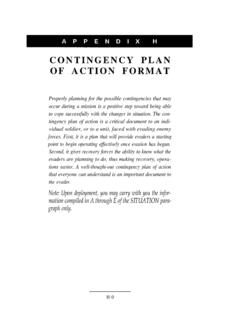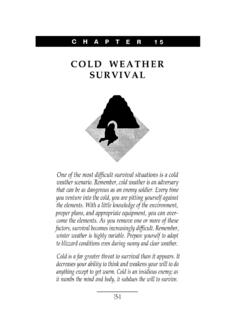Transcription of WATER PROCUREMENT - Equipped
1 WATERPROCUREMENTW ater is one of your most urgent needs in a survival situa-tion. You can t live long without it, especially in hot areaswhere you lose WATER rapidly through perspiration. Even incold areas, you need a minimum of 2 liters of WATER eachday to maintain than three-fourths of your body is composed offluids. Your body loses fluid as a result of heat, cold, stress,and exertion. To function effectively, you must replace thefluid your body loses. So, one of your first goals is to obtainan adequate supply of SOURCESA lmost any environment has WATER present to some degree. Figure 6-1lists possible sources of WATER in various environments. It also providesinformation on how to make the WATER : If you do not have a canteen, a cup, a can, or other type of container,improvise one from plastic or WATER -resistant cloth.
2 Shape the plastic or clothinto a bowl by pleating it. Use pins or other suitable items even yourhands to hold the you do not have a reliable source to replenish your WATER supply, stayalert for ways in which your environment can help not substitute the fluids listed in Figure 6-2 for dew can provide WATER . Tie rags or tufts of fine grass aroundyour ankles and walk through dew-covered grass before sunrise. As therags or grass tufts absorb the dew, wring the WATER into a the process until you have a supply of WATER or until the dew isgone. Australian natives sometimes mop up as much as a liter an hourthis or ants going into a hole in a tree may point to a WATER -filled the WATER with plastic tubing or scoop it up with an improviseddipper. You can also stuff cloth in the hole to absorb the WATER and thenwring it from the sometimes gathers in tree crotches or rock crevices.
3 Use theabove procedures to get the WATER . In arid areas, bird droppings arounda crack in the rocks may indicate WATER in or near the bamboo thickets are an excellent source of fresh WATER . Waterfrom green bamboo is clear and odorless. To get the WATER , bend a green6-5bamboo stalk, tie it down, and cut off the top (Figure 6-3). The WATER willdrip freely during the night. Old, cracked bamboo may contain the WATER before drinking you find banana or plantain trees, you can get WATER . Cutdown the tree, leaving about a 30-centimeter stump, and scoop out thecenter of the stump so that the hollow is bowl-shaped. WATER from theroots will immediately start to fill the hollow. The first three fillings ofwater will be bitter, but succeeding fillings will be palatable.
4 The stump(Figure 6-4) will supply WATER for up to four days. Be sure to cover it tokeep out tropical vines can give you WATER . Cut a notch in the vine as highas you can reach, then cut the vine off close to the ground. Catch thedropping liquid in a container or in your mouth (Figure 6-5).CAUTIONDo not drink the liquid if it is sticky, milky, or bitter milk from green (unripe) coconuts is a good thirst quencher. How-ever, the milk from mature coconuts contains an oil that acts as a laxa-tive. Drink in moderation the American tropics you may find large trees whose branches sup-port air plants. These air plants may hold a considerable amount of6-7rainwater in their overlapping, thickly growing leaves. Strain the waterthrough a cloth to remove insects and can get WATER from plants with moist pulpy centers.
5 Cut off a sec-tion of the plant and squeeze or smash the pulp so that the moistureruns out. Catch the liquid in a roots may provide WATER . Dig or pry the roots out of the ground,cut them into short pieces, and smash the pulp so that the moisture runsout. Catch the liquid in a leaves, stems, or stalks, such as bamboo, contain WATER . Cut ornotch the stalks at the base of a joint to drain out the following trees can also provide WATER :Palms. Palms, such as the buri, coconut, sugar, rattan, and nips,contain liquid. Bruise a lower frond and pull it down so the tree will bleed at the s tree. Found in Madagascar, this tree has a cuplike sheath atthe base of its leaves in which WATER tree. The leaf bases and roots of this tree of western tropicalAfrica can provide tree.
6 This tree of the sandy plains of northern Australia andAfrica collects WATER in its bottlelike trunk during the wet , you can find clear, fresh WATER in these trees after weeksof dry not keep the sap from plants longer than 24 hours. It begins fermenting,becoming dangerous as a WATER CONSTRUCTIONYou can use stills in various areas of the world. They draw moisturefrom the ground and from plant material. You need certain materials tobuild a still, and you need time to let it collect the WATER . It takes about24 hours to get to 1 liter of StillTo make the aboveground still, you need a sunny slope on which toplace the still, a clear plastic bag, green leafy vegetation, and a smallrock (Figure 6-6).To make the still Fill the bag with air by turning the opening into the breeze or by scooping air into the the plastic bag half to three-fourths full of green leafy vegeta-tion.
7 Be sure to remove all hard sticks or sharp spines that mightpuncture the not use poisonous vegetation. It will provide poisonous a small rock or similar item in the the bag and tie the mouth securely as close to the end of thebag as possible to keep the maximum amount of air space. If you6-9have a piece of tubing, a small straw, or a hollow reed, insert oneend in the mouth of the bag before you tie it securely. Then tie offor plug the tubing so that air will not escape. This tubing will allowyou to drain out condensed WATER without untying the the bag, mouth downhill, on a slope in full sunlight. Positionthe mouth of the bag slightly higher than the low point in the the bag in place so that the rock works itself into the low pointin the get the condensed WATER from the still, loosen the tie around thebag s mouth and tip the bag so that the WATER collected around the rockwill drain out.
8 Then retie the mouth securely and reposition the still toallow further the vegetation in the bag after extracting most of the waterfrom it. This will ensure maximum output of StillTo make a belowground still, you need a digging tool, a container, aclear plastic sheet, a drinking tube, and a rock (Figure 6-7).Select a site where you believe the soil will contain moisture (such asa dry stream bed or a low spot where rainwater has collected). Thesoil at this site should be easy to dig, and sunlight must hit the sitemost of the construct the still Dig a bowl-shaped hole about 1 meter across and 60 a sump in the center of the hole. The sump s depth andperimeter will depend on the size of the container that you haveto place in it. The bottom of the sump should allow the containerto stand the tubing to the container s bottom by forming a loose over-hand knot in the the container upright in the the unanchored end of the tubing up, over, and beyond thelip of the the plastic sheet over the hole, covering its edges with soil tohold it in a rock in the center of the plastic the plastic sheet into the hole until it is about 40 centimetersbelow ground level.
9 It now forms an inverted cone with the rockat its apex. Make sure that the cone s apex is directly over yourcontainer. Also make sure the plastic cone does not touch the sidesof the hole because the earth will absorb the condensed more soil on the edges of the plastic to hold it securely inplace and to prevent the loss of the tube when not in use so that the moisture will can drink WATER without disturbing the still by using the tube asa may want to use plants in the hole as a moisture source. If so, digout additional soil from the sides of the hole to form a slope on which toplace the plants. Then proceed as polluted WATER is your only moisture source, dig a small trough outsidethe hole about 25 centimeters from the still s lip (Figure 6-8). Dig thetrough about 25 centimeters deep and 8 centimeters wide.
10 Pour the pol-luted WATER in the trough. Be sure you do not spill any polluted wateraround the rim of the hole where the plastic sheet touches the soil. Thetrough holds the polluted WATER and the soil filters it as the still draws WATER then condenses on the plastic and drains into the process works extremely well when your only WATER source is will need at least three stills to meet your individual daily waterintake PURIFICATIONR ainwater collected in clean containers or in plants is usually safe fordrinking. However, purify WATER from lakes, ponds, swamps, springs, orstreams, especially the WATER near human settlements or in the possible, purify all WATER you got from vegetation or from theground by using iodine or chlorine, or by WATER by Using WATER purification tablets.




